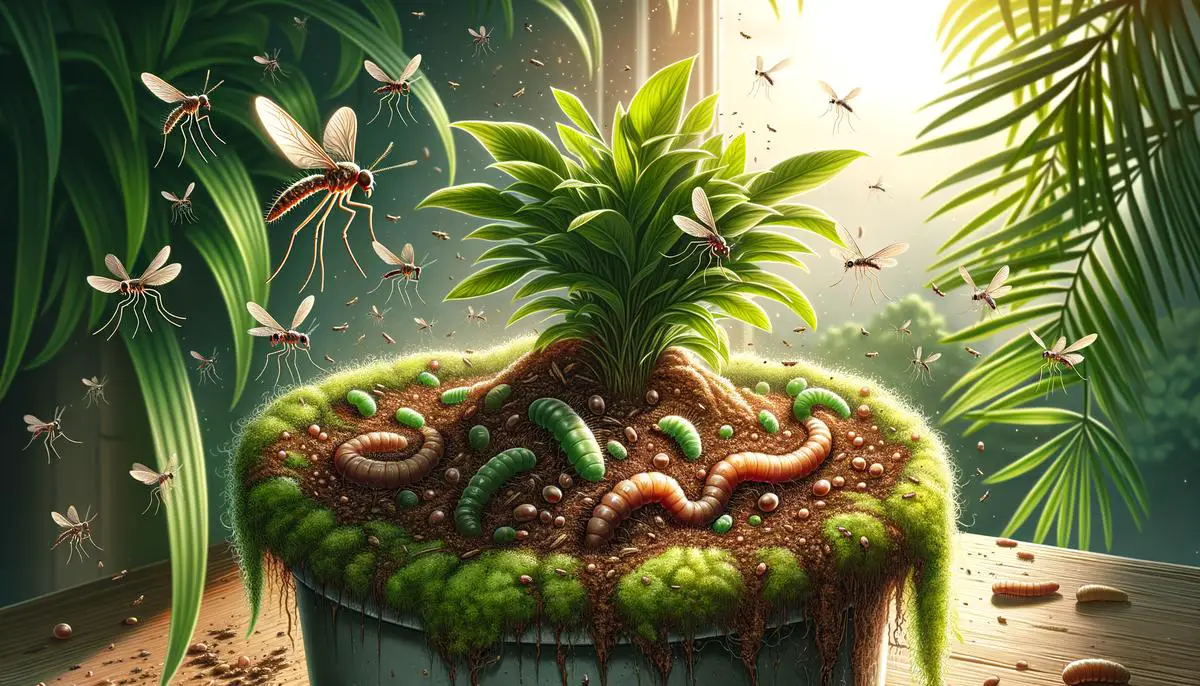Best Gnat Killer for Indoor Plants: Top Solutions

Identifying and managing gnats in your indoor garden can feel like a subtle art form, requiring a keen eye and a gentle touch. The presence of these tiny pests signals a need for immediate attention, guiding us towards adopting strategies that are as effective as they are environmentally friendly. This journey into the world of gnat management not only aims to protect our cherished plants but also to foster a healthier, more vibrant indoor ecosystem.
Identifying Gnats in Your Indoor Garden
Spotting tiny black gnats buzzing around your indoor greens is a dead giveaway of an infestation. These pests are especially fond of damp soil, making your overwatered houseplants prime targets for their eggs. If you notice an unusual number of these insects near your plants, it’s time to inspect further.
Watch out for adult gnats flying near the plant soil. They’re not just annoying – their presence indicates a bigger issue. These adults lay eggs in the soil, leading to a full-blown infestation. Observing gnats when watering your plants or seeing them hover over the soil surface during the day are glaring signs.
Finding larvae in the soil is another indicator of trouble. Up close, gnat larvae appear as tiny, white or transparent worms, thriving in moist soil conditions. A simple way to check for larvae is to gently dig around the top layer of soil; a strong infestation will make them easy to spot.
Gnats might seem harmless, but they’re more than just a nuisance. Their larvae feed on the organic matter in the soil and can harm tender plant roots. Young seedlings are particularly vulnerable. Over time, you might notice your plant’s growth stunting or its leaves turning yellow, signaling distress from root damage.
Another clue? Fungus gnat larvae fungal growth on the surface of the soil, propelled by overwatering and poor drainage. This mold serves as a food source for the larvae, further encouraging their presence.
The damage caused by gnats shouldn’t be underestimated. Besides physical harm to your plants, a gnat infestation can also introduce harmful pathogens. As larvae munch on plant roots, they open the door for disease, compounding your plant care troubles.
To catch an infestation early, regularly inspect your plants for signs of gnats and take preventive measures against overwatering. Well-draining soil and proper watering techniques are your best defense against these pesky invaders. Paying close attention to these signs can help save your indoor garden from a gnat infestation’s grip, protecting your plants’ health and keeping your home pest-free.

Natural Gnat Management Strategies
Turning the tide against gnats requires an armory of eco-friendly solutions, starting with the ancient wisdom of neem oil. Extracted from the seeds of the neem tree, this natural insecticide works wonders when a teaspoon is mixed with a quart of water and a few drops of dish soap. This concoction, after a vigorous shake, is ready for battle—spray it directly onto the soil to bid farewell to gnats seeking refuge in your indoor garden.
Dish soap, the unsung hero of household cleaning, stands at the frontline against gnats. Combine a tablespoon of gentle, fragrance-free liquid soap with two cups of water. This simple mixture, once sprayed onto the afflicted plant’s soil, cuts through the gnat population without mercy, disrupting their life cycle. The key here is consistency; reapplication every few days ensures any newcomers are promptly escorted out.
No gnat combat strategy is complete without the trusty sticky traps. These unassuming sheets of bright yellow paper coated in a sticky substance are the equivalent of a no-fly zone for gnats. Positioning a few around your plants forms an impenetrable fortress; gnats drawn to the yellow color meet their sticky end, leaving your plants in peace.
In a surprising twist, tiny microscopic warriors known as beneficial nematodes (Steinernema feltiae) join the fray. Invisible to the naked eye, these beneficial organisms wage war beneath the soil, hunting down gnat larvae with precision. Mixing a pack with water and saturating the soil brings an army of allies to your plants’ roots, setting up a covert operation against gnats from within.
Each of these eco-friendly methods carries its own set of instructions and expected outcomes. Neem oil treats and prevents further infestations by creating an inhospitable environment for gnats. The soap water mixture acts fast, cutting down the adult population and disrupting larvae development on contact. Sticky traps serve as an ongoing monitoring system, providing a visual account of the battle’s progress. Beneficial nematodes work from the ground up, dealing a fatal blow to larvae lurking in the soil.
Success in this leafy battlefield relies on a combined arms approach. Regular application and patience allow these natural remedies to weave their magic, protecting your indoor oasis from gnats. Adapt these strategies as needed, and watch as your plants thrive in a gnat-free environment, a testament to the power of green solutions in preserving nature’s beauty indoors.

Preventive Measures to Keep Gnats at Bay
To ensure a future where your indoor plants thrive without the nuisance of gnats, it’s essential to discuss the critical role of soil choice in your preventive arsenal. Opt for soil mixes labeled specifically for indoor plants, which tend to be better structured to prevent water retention that attracts gnats. Additionally, incorporating a layer of sand on top of your potting soil can deter gnats from laying eggs, as they’re less likely to penetrate the sand to reach the damp soil below.
Watering routines demand a fine balance; it’s not just about quantity but also timing. Ensure your plants dry out sufficiently between waterings. A straightforward technique is the finger test; if the soil is dry an inch below the surface, it’s time to water. Proper watering goes hand in hand with pot choice—the pots should have adequate drainage to avoid standing water, a primary attraction for gnats.
Cleanliness in your indoor garden cannot be overstated. Remove dead leaves and debris promptly from the topsoil and around your plants. This practice helps in two ways: it removes potential food sources for gnat larvae and reduces the habitats that gnats use for breeding.
Welcoming new plants into your home can feel like introducing new members into your family. However, even these require a period of quarantine. Keeping new plants isolated for a short period allows you to monitor them for any signs of gnat infestation without risking your current indoor garden. It’s a step that requires patience but pays off by ensuring that one plant’s issue doesn’t become a house-wide problem.
By closely managing the moisture, you can create a less inviting environment for gnats. Consider using humidity trays filled with pebbles; these allow any excess water to drain away from the plant pot, minimizing the damp conditions that gnats adore. Not just effective, this method also adds an aesthetic touch to your plant decor.
Monitoring your plants plays a crucial role in early detection and prevention. Keep an eye out for any changes in the soil’s condition or unexpected dampness. Using tools like a moisture meter can take the guesswork out of this process, providing you with precise information about the soil’s moisture level.
Engagement with these practices fosters a symbiotic relationship between you and your indoor garden. Beyond mere routines, these measures embody a proactive stance towards plant care, ensuring your green companions not only survive but flourish, all while keeping those pesky gnats at bay. Together, these strategies form a comprehensive defense, safeguarding the health and beauty of your indoor garden.

In the end, the most critical aspect of keeping gnats at bay lies in the simple yet powerful practice of regular plant inspection and moisture management. By embracing this approach, we arm ourselves with the knowledge and tools necessary to maintain a thriving indoor garden, free from the unwelcome advances of gnats. It’s a testament to the effectiveness of proactive care and natural remedies in preserving the beauty and health of our plant companions.
